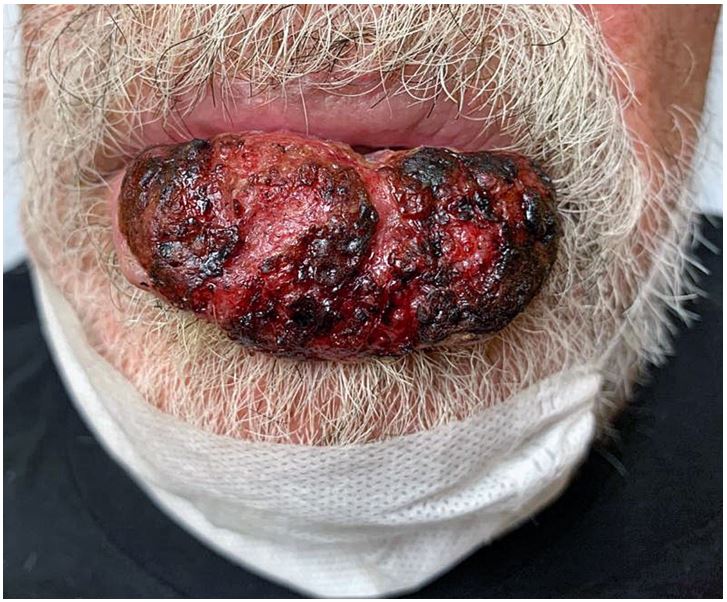Clinical Image - Volume 3 - Issue 6
Squamous cell carcinoma of the lower lip
Julio C. Salas-Alanís1; Mauricio Salas-Garza2; María G. Moreno-Treviño3; Gerardo Rivera-Silva3*
1Dermatological Institute of Jalisco, Zapopan, JAL, Mexico.
2Debra Foundation Mexico, Monterrey, NL, Mexico.
3Academic Department, School of Medicine, University of Monterrey, Monterrey, NL, Mexico.
Received Date : Oct 31, 2023
Accepted Date : Nov 17, 2023
Published Date: Nov 24, 2023
Copyright:© Gerardo Rivera Silva 2023
*Corresponding Author : : Gerardo Rivera Silva, Academic Department, School of Medicine, University of Monterrey. Av. I. Morones Prieto # 4500 Pte, San Pedro Garza Garcia, NL, 66238, Mexico.
Email: gerardorivera88@gmail.com
DOI: Doi.org/10.55920/2771-019X/1586
Clinical Image
A 72-year-old male farmer came to our clinic with a tumor in his lower lip. The patient had a history of arterial hypertension, with a chronic and intense exposure to sunlight, and smoking (30 pack-year) for 45 years. He informed us that the tumor in his lower lip had appeared as a small ulcer for two years which gradually increased in size. Physical examination showed a fungating and bleeding lower lip tumor (Figure.1). Histopathologic analysis revealed grade 1 or well differentiated squamous cell carcinoma (SCC) characterized by atypical mitosis, keratin pearls with islet invasion pattern and mononuclear infiltration. The clinical diagnosis was SSC of the lower lip.
SCC of the lower lip is a frequent cancer involving 25% to 30% of all oral malignant tumors. It appears most commonly in male patients (6:1) and it is associated with exposure to sunlight for long periods of time, or with tobacco and alcohol abuse. Its diagnosis in early phases has a good prognosis, with a survival rate above 90% at the 5-year follow-up. There are several therapeutic options, and they were presented to the patient. Surgical procedure is presently the best treatment of SCC; however, it has been related with aesthetic and functional imperfections. Photodynamic therapy is a palliat ive non-invasive treatment that is an alternative for patients who are not eligible for radiation and surgery, when a local and regional propagation exist, and with a tolerable harmfulness profile. The patient had an illness with a good survival percentage. However, the patient refused the treatment. For this reason his cancer would advance quickly with the risk of being incurable and receiving palliative radiation as the only therapeutic option.

Figure 1: General appearance of the lower lip tumor.

